Bach House: experience the history of the childhood & music of the „city's greatest son“
Inhalt
Since its foundation in 1907, the Bach House in Eisenach - the first ever museum dedicated to Johann Sebastian Bach - has devoted itself to the life, art and astonishing legacy of the master.
Often wrongly assumed to be the birthplace of Bach in Eisenach, which has not been preserved, it is nevertheless one of the largest and most visited music museums in Germany. The Bach House, which is now located in another building owned by the family, offers a fascinating journey through the life and music of the composer. Here, in the centre of the historic city, Johann Sebastian Bach spent his early childhood and took his first musical steps.
With its renowned exhibition, the Bachhaus in Eisenach has achieved national and international recognition - from awards such as the Bronze Award from the Art Directors Club in 2008 to the honour of being recognised by US President Clinton in 1998 for the museum's contribution to communicating the town's history.
The museum not only celebrates Bach's artistic legacy, but also offers visitors an award-winning presentation that brings his art and life to life in a variety of ways.
Why you should definitely visit the Bach House
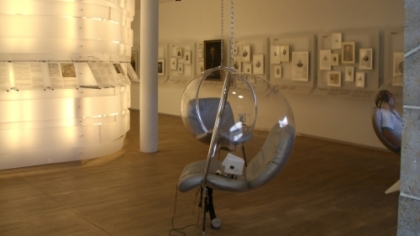
© Christoph Radtke
- One of the largest and most visited music museums in Germany: The Bach House is home to one of the most comprehensive exhibitions on Johann Sebastian Bach's life and music. With over 300 original exhibits spread over 600 square metres, it offers visitors a fascinating journey through the life and art of the composer. Since 2007, the museum has welcomed around 60,000 visitors a year.
- The first, and therefore oldest, museum dedicated to Johann Sebastian Bach: The Bach House was founded in 1907 by the Bach Society of the time. Its mission was literally „to collect and preserve everything relating to Johann Sebastian Bach and his life's work".
- Multi-award-winning presentation: The exhibition in the Bachhaus, designed by Atelier Brückner from Stuttgart, received the ADC bronze award for its overall presentation. The museum was a finalist at the World Media Festival and received the special scenography prize from the Association of German Interior Architects (BDIA) in 2008. The museum also impresses with the light installation „IN VERSUS F: Light as Score - Architecture as Sound" by Saarbruecken light artist Ingo Bracke, which can be admired on Saturday evenings and the evenings before public holidays.
- Experience and understand Bach's music: The Bach House offers its visitors the opportunity to experience and understand Johann Sebastian Bach's music in a variety of ways. This includes the recreated living rooms of the family, a theological library corresponding to Bach's estate, mini-concerts in the instrument hall, an exhibition on the reception of Bach up to the present day, interactive elements and listening stations, right through to the „bubble chairs" created by Finnish designer Eero Aarnio.
This is exhibited in the Bachhaus
The exhibition at the Bach House in Eisenach is divided into three main components: the original exhibits range from the historical living quarters and the theological library to the stages of Bach's life and the enigmatic Bach Cup. The new building of the Bach House presents the experience and understanding of Bach's works, as well as their reception up to the present day. Outside, the light installation, the Bach House garden and the Bach memorial emphasise the historical location.
The exhibits in the Bachhaus form the centrepiece of the classical exhibition, which sheds light on the life and work of Johann Sebastian Bach in Eisenach and on his subsequent path.
- „Historic living rooms“: Here, the bedroom, living room and kitchen are modelled on Johann Sebastian Bach's birthplace, which no longer exists. The historical furnishings date from the 17th century and provide an insight into the life of the Bach family.
- „Theological Library“: Based on Bach's estate catalogue, it presents 52 theological book titles in 81 volumes and thus reflects „Bach's inner world“.
- „Town Pipe Room“: It tells the story of Bach's father Ambrosius, who ran the town pipe workshop, as well as Johann Sebastian's school days in Eisenach. Not only are typical town piper instruments on display here, but also replicas of school documents from the town archives, which document Bach's and his fellow pupils' frequent absences for the morning „quinta", as well as the intensive music lessons.
- „Instrument Room“: This area displays a selection of 28 Baroque musical instruments from the museum's collection of 400 pieces - including the keyboard instruments that are presented in the exhibition's mini-concerts every hour.
- „Bach's life stages“ & the Bach Cup: The first room on the upper floor presents Bach's musical life stages from his childhood in Eisenach to his death in Leipzig. The Bach Cup, one of the few surviving objects from Bach's household, remains a mystery with its elaborate decorations and unexplained circumstances of its presentation, but was probably a gift from his pupils for his 50th birthday.
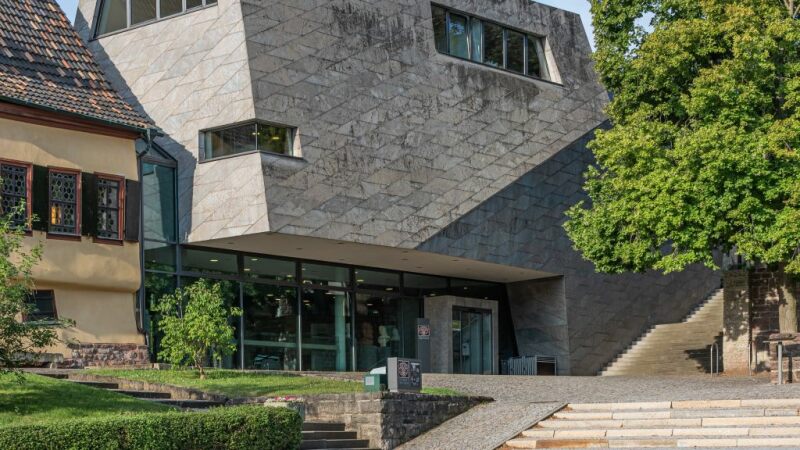
© A.Savin, FAL
In the new Bachhaus building opened in 2007, three worlds of experience form another key part of the exhibition: „How we see Bach“, „What we know about Bach“ and „How we play Bach“. These include media installations such as the „Bubble Chairs“ and the „Walkable Piece of Music“, as well as an original Bach autograph of his cantata „Alles nur nach Gottes Willen“.
- „How we see Bach“: This exhibition shows the iconography of Bach from contemporary depictions to the present day, presented in original artefacts.
- „What we know about Bach“: Here you can find out everything about Bach research, from the first Bach biographies to the reconstruction of lost compositions. There is also a true-to-original catalogue of Bach's works and Bach biographies in German, English, French and Japanese.
- „How we play Bach“: This section looks at Bach performance practice since the composer's death - from the dissemination by Bach's sons to Felix Mendelssohn Bartholdy's interpretation of the St Matthew Passion and today's pop culture.
- Bach autograph: This manuscript comprises an opening chorus and a recitative by Bach's nephew, an aria by Bach's wife Anna Magdalena and the final chorale, transcriptions and signatures, corrections and notes by Bach himself. At an audio station, visitors can listen to the musical commentary by the Franco-German doctor, philosopher and musicologist Albert Schweitzer.
- „Bubble Chairs“: These suspended seating shells were designed by Finnish designer Eero Aarnio in 1968. Here you can listen to five different works by Johann Sebastian Bach.
- „Walk-in piece of music“: This installation comprises 13 listening stations on a sound wave-like curved outer skin. Here, musical issues and genres of Bach's time are explained with audio examples. Inside, there are 4 exhibits on aspects of Bach's music and an exhibition with a 180° screen showing a film production of a Bach performance by Berlin director Marc Tamschick together with the composer Marc Lingk.
The Bach House garden, the Bach memorial and the light installation „IN VERSUS F“ round off the presentation of the Bach House in Eisenach as external components of the overall concept of the exhibition.
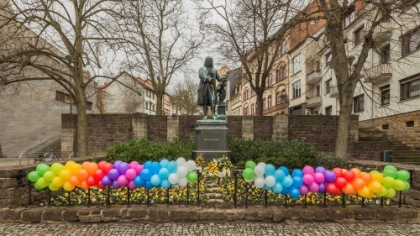
© NoRud, CC BY-SA 4.0
The Bach Monument is, like the museum, the oldest figurative monument to Johann Sebastian Bach.
The Garden of the Bachhaus, on the other hand, is a protected inner-city garden monument whose original location of the fountain has been preserved. Annahmen zufolge diente der Barockgarten einst als Gemüse- und Obstgarten oder sogar als Viehweide. It is also home to the „Café Kantate“, where visitors can stop off for a sweet treat.
The light installation „IN VERSUS F: Light as score - architecture as sound“ by Saarbrücken light artist Ingo Bracke is another highlight.
Since 21 March 2011, this installation has been illuminated on all Saturday evenings and on the eve of public holidays from dusk until 11:00 pm.
What was Bach doing in Eisenach?
Johann Sebastian Bach, born on 31 March 1685, was the youngest of eight children of the town piper Johann Ambrosius Bach and his wife Maria Elisabeth.
The town of Eisenach had around 6,000 inhabitants at the time and was the residential town of the Principality of Saxe-Eisenach. As the leader of the town musicians and court trumpeter to Dukes Johann Georg I and Johann Georg II of Saxe-Eisenach, his father probably acquired several properties here in return for his citizenship of the town. These included the house where Johann Sebastian was born and today's Bach House.
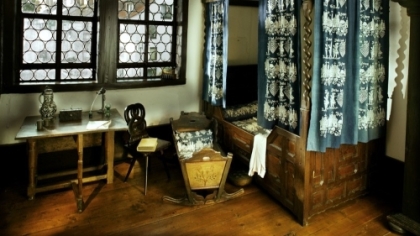
© Bachhaus.eisenach, CC BY-SA 3.0
Even though the house where he was born has probably not been preserved, Bach spent his early childhood in Eisenach and laid the foundations for his development here, which would forever bind him to the town.
His musical roots in Eisenach were significantly influenced by his father and his cousin. Ambrosius taught Johann Sebastian the basics of playing the violin, while Johann Christoph Bach, as organist of Eisenach's Georgenkirche, played a significant role in Bach's first encounter with church and organ music.
At the age of eight, Johann Sebastian attended the Latin school in the former Dominican monastery, having presumably previously been taught at the „German school". During this time, Bach received music lessons four times a week at the school, which benefited his musical abilities.
Johann Sebastian Bach, who was regarded as a bright child and one of the best pupils from his first year at school, received a conspicuous number of entries for absences (96, 59 and 103) between 1693 and 1695, most probably due to his assistance in his father's music business.
After the death of his mother in 1694 and his father in 1695, Bach moved in with his older brother in Ohrdruf.
Despite his early departure, Johann Sebastian Bach remained connected to Eisenach throughout his life and always referred to himself as „Isenacus“ (from Eisenach).
Concerts and events at the Bachhaus
Visitors to the Bachhaus Eisenach can expect regular concerts that turn the museum into a lively venue for musical performances, as well as special exhibitions, readings and visitor programmes for children and young people.
Since 1973, hourly mini-concerts have been offered in the 63-seat instrument hall, where keyboard instruments from various eras are presented.
These entertaining, approximately 20-minute performances present a variety of instruments from Bach's time, including two organ positives, a bound clavichord, a spinet and a harpsichord. A remarkable highlight is the Thuringian organ positive, which is considered to be the oldest preserved organ of its kind and was possibly known to Bach himself. Visitors can activate this instrument themselves during the concert, as the organ's air supply requires the manual operation of a bellows by another person.
The Bachhaus also has its own concert series with around 10 events per year.
Special festive concerts take place at Christmas, New Year and on Bach's birthday, allowing visitors to experience the Bachhaus not only as a museum, but also as a space for music and concerts.
The Bachhaus is also actively involved in regional music festivals such as the „Thüringer Bachwochen“ and the „Güldener Herbst“.
The museum education programmes are held in a separate room and focus on different topics:
- Bach's biography: „A fight, prison, two wives and 20 children“
- Life around 1700: „Cabbage and turnips have driven me away...“
- Bach quiz: „Bach-Blüten“
- Musical instruments of the Baroque: „With quill pen and pig bristle“
- Bach adaptations: „What would Bach have said?“
- Bach and the dance: „May I have the honour?“
Free working material is also available to download for each of these programmes.

© Bachhaus.eisenach, CC BY-SA 3.0
Opening hours, prices & special programmes
The Bachhaus Eisenach is open every weekday from 10 am to 6 pm. The museum recommends that you allow at least 60 minutes for a visit.
Guided tours and events can also be organised outside opening hours by prior arrangement.
Here is an overview of the regular admission prices for the museum:
| Persons | Price |
|---|---|
| Adults | 12.00 € |
| Groups of 10 people or more | 9.50 € per person |
| Concessions (pupils, students, severely disabled persons) | 7.00 € |
| Family card (parents with school children) | 26.00 € |
| Children under 6 years | free |
| Members of the Neue Bachgesellschaft | free |
| 20-minute concert in the instrument hall | Included in the admission price |
In addition to the exhibition, the Bachhaus also has many other programmes on offer. These include, for example, the „Historical Evening Music“, a concert organised for closed groups on historical instruments - including a champagne reception and guided tour of the museum.
| Programme | Duration | Times | Price |
|---|---|---|---|
| Special guided tours (10-30 persons) | 75 min. | Mon - Fri: 10-18 h Sat/Sun, public holidays, outside opening hours | 70.00 € plus entrance fee 120.00 € plus entrance fee |
| City tours Costume tours (up to 30 persons) | 90 – 120 min. | daily, time by arrangement | 85.00 € plus admission 120.00 € plus admission |
| Evening music for up to 25 people Evening music for 25 people or more | 90 min. | daily, from 6 pm | 540.00 € all-inclusive 22.00 € per person |
| School programmes (10-30 people) | 60 min. | Mon - Fri: 9-18 o'clock | 7.00 € per student 2 accompanying persons free |
The city tours stop at the following places: the market square and town hall, St George's Church with its historic organ, choir stalls and Bach's baptismal font, the old cemetery where Bach's parents are buried, the Latin school in the preacher's monastery, the town whistle tower and the Bach family's first home in Eisenach.
In terms of content, the city tours not only cover Bach, but of course also the general history of the city and other influential figures in the city's history, such as Luther, St Elisabeth, Telemann, Goethe and Wagner.
Travelling by car, bus or train
You can arrive by bus or train at the railway station and bus station in Eisenach. These are located right next to each other and close to the town centre, from where the Bachhaus is not far away.
The walk from the railway stations is short at 11 minutes. Nevertheless, if you want to use the trip efficiently, you should invest a few more minutes. Because on the way through the city to the Bachhaus, there is also Nikolai Church and Nikolaitor, The Karlsplatz with Luther monument and doctors' monument, as well as the "Narrow House of Eisenach" - and many cafés, restaurants and shopping facilities.
By car you can reach the city from Frankfurt via the A4 at the Eisenach-West exit, from where the shortest route to the Bachhaus leads from the B19 to the B84 and then via Katharinenstraße into the city centre to Frauenplan. However, a more convenient route is to bypass the old town area and instead of travelling to Katharinenstraße, turn off onto Rennbahn beforehand and then follow the B19 southwards to the Alte Brauerei.
If you are travelling from Erfurt, take the Eisenach-Ost exit and then follow the B84 to the town, from where the B19 will take you close to your destination.
Parking options include near the railway stations at the „Tor zur Stadt“, with plenty of space for just €6 per day, at the old brewery, with 87 parking spaces for €8 per day, and finally directly in front of the Bachhaus on Frauenplan, although parking is limited and only 20 spaces are available.
Cover photo: NoRud, CC BY-SA 4.0

 DE
DE 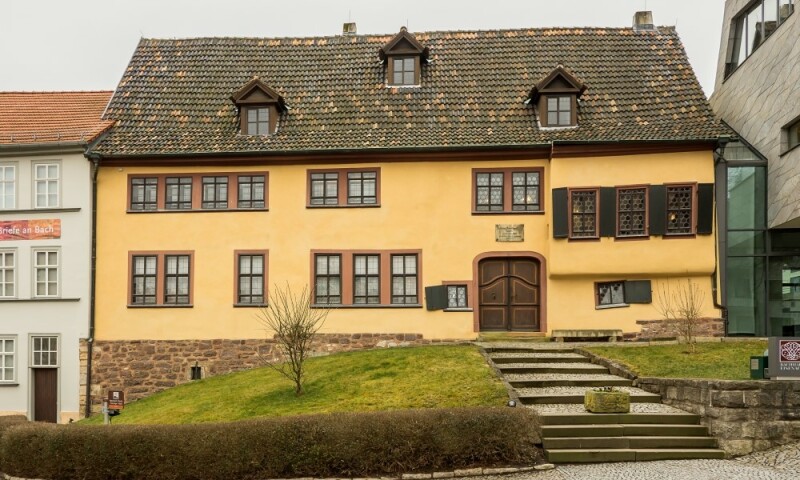

Questions & Comments
or post as a guest